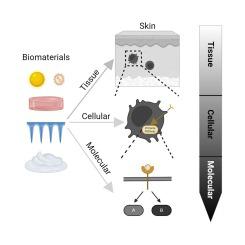当前位置:
X-MOL 学术
›
Adv. Drug Deliver. Rev.
›
论文详情
Our official English website, www.x-mol.net, welcomes your
feedback! (Note: you will need to create a separate account there.)
Advancing immunotherapy using biomaterials to control tissue, cellular, and molecular level immune signaling in skin
Advanced Drug Delivery Reviews ( IF 15.2 ) Pub Date : 2024-04-25 , DOI: 10.1016/j.addr.2024.115315 Shrey A Shah 1 , Robert S Oakes 2 , Christopher M Jewell 3
Advanced Drug Delivery Reviews ( IF 15.2 ) Pub Date : 2024-04-25 , DOI: 10.1016/j.addr.2024.115315 Shrey A Shah 1 , Robert S Oakes 2 , Christopher M Jewell 3
Affiliation

|
Immunotherapies have been transformative in many areas, including cancer treatments, allergies, and autoimmune diseases. However, significant challenges persist in extending the reach of these technologies to new indications and patients. Some of the major hurdles include narrow applicability to patient groups, transient efficacy, high cost burdens, poor immunogenicity, and side effects or off-target toxicity that results from lack of disease-specificity and inefficient delivery. Thus, there is a significant need for strategies that control immune responses generated by immunotherapies while targeting infection, cancer, allergy, and autoimmunity. Being the outermost barrier of the body and the first line of host defense, the skin presents a unique immunological interface to achieve these goals. The skin contains a high concentration of specialized immune cells, such as antigen-presenting cells and tissue-resident memory T cells. These cells feature diverse and potent combinations of immune receptors, providing access to cellular and molecular level control to modulate immune responses. Thus, skin provides accessible tissue, cellular, and molecular level controls that can be harnessed to improve immunotherapies. Biomaterial platforms – microneedles, nano- and micro-particles, scaffolds, and other technologies – are uniquely capable of modulating the specialized immunological niche in skin by targeting these distinct biological levels of control. This review highlights recent pre-clinical and clinical advances in biomaterial-based approaches to target and modulate immune signaling in the skin at the tissue, cellular, and molecular levels for immunotherapeutic applications. We begin by discussing skin cytoarchitecture and resident immune cells to establish the biological rationale for skin-targeting immunotherapies. This is followed by a critical presentation of biomaterial-based pre-clinical and clinical studies aimed at controlling the immune response in the skin for immunotherapy and therapeutic vaccine applications in cancer, allergy, and autoimmunity.
中文翻译:

使用生物材料控制皮肤组织、细胞和分子水平的免疫信号推进免疫治疗
免疫疗法在许多领域都具有变革性,包括癌症治疗、过敏和自身免疫性疾病。然而,将这些技术的应用范围扩展到新的适应症和患者方面仍然存在重大挑战。一些主要障碍包括对患者群体的适用性狭窄、疗效短暂、成本负担高、免疫原性差以及由于缺乏疾病特异性和递送效率低而导致的副作用或脱靶毒性。因此,非常需要控制免疫疗法产生的免疫反应,同时针对感染、癌症、过敏和自身免疫的策略。作为身体最外层的屏障和宿主防御的第一道防线,皮肤提供了独特的免疫界面来实现这些目标。皮肤含有高浓度的特殊免疫细胞,例如抗原呈递细胞和组织驻留记忆 T 细胞。这些细胞具有多种有效的免疫受体组合,提供细胞和分子水平控制来调节免疫反应。因此,皮肤提供了可访问的组织、细胞和分子水平控制,可用于改善免疫疗法。生物材料平台——微针、纳米和微米颗粒、支架和其他技术——能够通过针对这些不同的生物控制水平来调节皮肤中的专门免疫生态位。本综述重点介绍了基于生物材料的方法在组织、细胞和分子水平上靶向和调节皮肤免疫信号传导以用于免疫治疗应用的最新临床前和临床进展。 我们首先讨论皮肤细胞结构和常驻免疫细胞,以确定皮肤靶向免疫疗法的生物学原理。接下来是基于生物材料的临床前和临床研究的重要介绍,旨在控制皮肤的免疫反应,以用于癌症、过敏和自身免疫的免疫治疗和治疗性疫苗应用。
更新日期:2024-04-25
中文翻译:

使用生物材料控制皮肤组织、细胞和分子水平的免疫信号推进免疫治疗
免疫疗法在许多领域都具有变革性,包括癌症治疗、过敏和自身免疫性疾病。然而,将这些技术的应用范围扩展到新的适应症和患者方面仍然存在重大挑战。一些主要障碍包括对患者群体的适用性狭窄、疗效短暂、成本负担高、免疫原性差以及由于缺乏疾病特异性和递送效率低而导致的副作用或脱靶毒性。因此,非常需要控制免疫疗法产生的免疫反应,同时针对感染、癌症、过敏和自身免疫的策略。作为身体最外层的屏障和宿主防御的第一道防线,皮肤提供了独特的免疫界面来实现这些目标。皮肤含有高浓度的特殊免疫细胞,例如抗原呈递细胞和组织驻留记忆 T 细胞。这些细胞具有多种有效的免疫受体组合,提供细胞和分子水平控制来调节免疫反应。因此,皮肤提供了可访问的组织、细胞和分子水平控制,可用于改善免疫疗法。生物材料平台——微针、纳米和微米颗粒、支架和其他技术——能够通过针对这些不同的生物控制水平来调节皮肤中的专门免疫生态位。本综述重点介绍了基于生物材料的方法在组织、细胞和分子水平上靶向和调节皮肤免疫信号传导以用于免疫治疗应用的最新临床前和临床进展。 我们首先讨论皮肤细胞结构和常驻免疫细胞,以确定皮肤靶向免疫疗法的生物学原理。接下来是基于生物材料的临床前和临床研究的重要介绍,旨在控制皮肤的免疫反应,以用于癌症、过敏和自身免疫的免疫治疗和治疗性疫苗应用。


















































 京公网安备 11010802027423号
京公网安备 11010802027423号